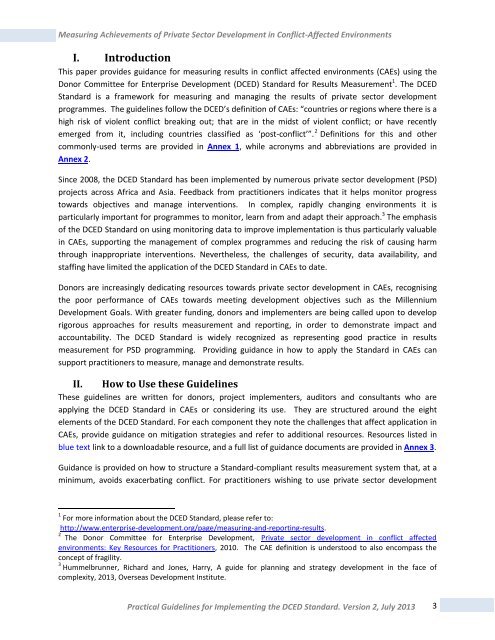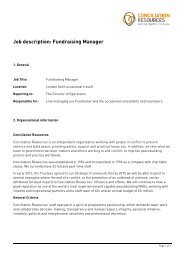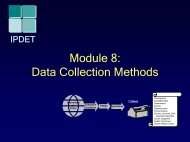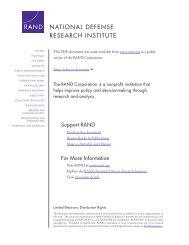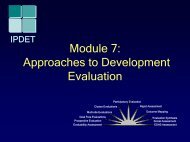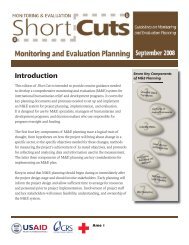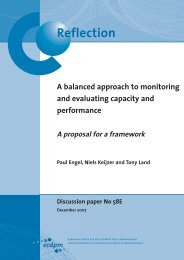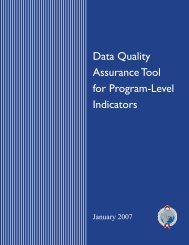Measuring Achievements of Private Sector Development in ... - DCED
Measuring Achievements of Private Sector Development in ... - DCED
Measuring Achievements of Private Sector Development in ... - DCED
Create successful ePaper yourself
Turn your PDF publications into a flip-book with our unique Google optimized e-Paper software.
<strong>Measur<strong>in</strong>g</strong> <strong>Achievements</strong> <strong>of</strong> <strong>Private</strong> <strong>Sector</strong> <strong>Development</strong> <strong>in</strong> Conflict-Affected Environments<br />
I. Introduction<br />
This paper provides guidance for measur<strong>in</strong>g results <strong>in</strong> conflict affected environments (CAEs) us<strong>in</strong>g the<br />
Donor Committee for Enterprise <strong>Development</strong> (<strong>DCED</strong>) Standard for Results Measurement 1 . The <strong>DCED</strong><br />
Standard is a framework for measur<strong>in</strong>g and manag<strong>in</strong>g the results <strong>of</strong> private sector development<br />
programmes. The guidel<strong>in</strong>es follow the <strong>DCED</strong>’s def<strong>in</strong>ition <strong>of</strong> CAEs: “countries or regions where there is a<br />
high risk <strong>of</strong> violent conflict break<strong>in</strong>g out; that are <strong>in</strong> the midst <strong>of</strong> violent conflict; or have recently<br />
emerged from it, <strong>in</strong>clud<strong>in</strong>g countries classified as ‘post-conflict’”. 2 Def<strong>in</strong>itions for this and other<br />
commonly-used terms are provided <strong>in</strong> Annex 1, while acronyms and abbreviations are provided <strong>in</strong><br />
Annex 2.<br />
S<strong>in</strong>ce 2008, the <strong>DCED</strong> Standard has been implemented by numerous private sector development (PSD)<br />
projects across Africa and Asia. Feedback from practitioners <strong>in</strong>dicates that it helps monitor progress<br />
towards objectives and manage <strong>in</strong>terventions. In complex, rapidly chang<strong>in</strong>g environments it is<br />
particularly important for programmes to monitor, learn from and adapt their approach. 3 The emphasis<br />
<strong>of</strong> the <strong>DCED</strong> Standard on us<strong>in</strong>g monitor<strong>in</strong>g data to improve implementation is thus particularly valuable<br />
<strong>in</strong> CAEs, support<strong>in</strong>g the management <strong>of</strong> complex programmes and reduc<strong>in</strong>g the risk <strong>of</strong> caus<strong>in</strong>g harm<br />
through <strong>in</strong>appropriate <strong>in</strong>terventions. Nevertheless, the challenges <strong>of</strong> security, data availability, and<br />
staff<strong>in</strong>g have limited the application <strong>of</strong> the <strong>DCED</strong> Standard <strong>in</strong> CAEs to date.<br />
Donors are <strong>in</strong>creas<strong>in</strong>gly dedicat<strong>in</strong>g resources towards private sector development <strong>in</strong> CAEs, recognis<strong>in</strong>g<br />
the poor performance <strong>of</strong> CAEs towards meet<strong>in</strong>g development objectives such as the Millennium<br />
<strong>Development</strong> Goals. With greater fund<strong>in</strong>g, donors and implementers are be<strong>in</strong>g called upon to develop<br />
rigorous approaches for results measurement and report<strong>in</strong>g, <strong>in</strong> order to demonstrate impact and<br />
accountability. The <strong>DCED</strong> Standard is widely recognized as represent<strong>in</strong>g good practice <strong>in</strong> results<br />
measurement for PSD programm<strong>in</strong>g. Provid<strong>in</strong>g guidance <strong>in</strong> how to apply the Standard <strong>in</strong> CAEs can<br />
support practitioners to measure, manage and demonstrate results.<br />
II. How to Use these Guidel<strong>in</strong>es<br />
These guidel<strong>in</strong>es are written for donors, project implementers, auditors and consultants who are<br />
apply<strong>in</strong>g the <strong>DCED</strong> Standard <strong>in</strong> CAEs or consider<strong>in</strong>g its use. They are structured around the eight<br />
elements <strong>of</strong> the <strong>DCED</strong> Standard. For each component they note the challenges that affect application <strong>in</strong><br />
CAEs, provide guidance on mitigation strategies and refer to additional resources. Resources listed <strong>in</strong><br />
blue text l<strong>in</strong>k to a downloadable resource, and a full list <strong>of</strong> guidance documents are provided <strong>in</strong> Annex 3.<br />
Guidance is provided on how to structure a Standard-compliant results measurement system that, at a<br />
m<strong>in</strong>imum, avoids exacerbat<strong>in</strong>g conflict. For practitioners wish<strong>in</strong>g to use private sector development<br />
1 For more <strong>in</strong>formation about the <strong>DCED</strong> Standard, please refer to:<br />
http://www.enterprise-development.org/page/measur<strong>in</strong>g-and-report<strong>in</strong>g-results.<br />
2 The Donor Committee for Enterprise <strong>Development</strong>, <strong>Private</strong> sector development <strong>in</strong> conflict affected<br />
environments: Key Resources for Practitioners, 2010. The CAE def<strong>in</strong>ition is understood to also encompass the<br />
concept <strong>of</strong> fragility.<br />
3 Hummelbrunner, Richard and Jones, Harry, A guide for plann<strong>in</strong>g and strategy development <strong>in</strong> the face <strong>of</strong><br />
complexity, 2013, Overseas <strong>Development</strong> Institute.<br />
Practical Guidel<strong>in</strong>es for Implement<strong>in</strong>g the <strong>DCED</strong> Standard. Version 2, July 2013<br />
3


